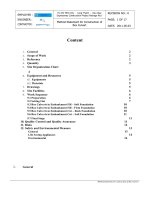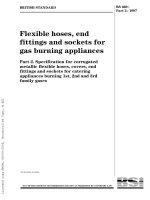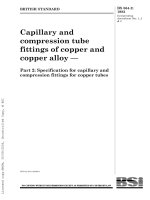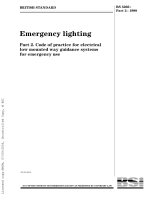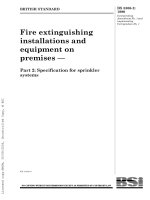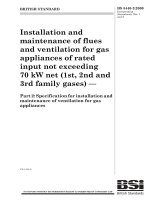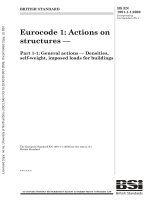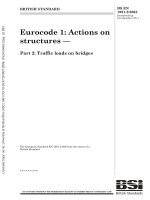Bsi bs en 00794 1 1997 (2001) bs 05724 2 202 1997
Bạn đang xem bản rút gọn của tài liệu. Xem và tải ngay bản đầy đủ của tài liệu tại đây (456 KB, 38 trang )
BRITISH STANDARD
BS EN
794-1:1997
BS 5724-2.202:
1997
Incorporating
Amendment No. 1
Lung ventilators —
Part 1: Particular requirements for
critical care ventilators
The European Standard EN 794-1:1997, with the incorporation of
amendment A1:2000, has the status of a British Standard
ICS 11.040.10
NO COPYING WITHOUT BSI PERMISSION EXCEPT AS PERMITTED BY COPYRIGHT LAW
BS EN 794-1:1997
Committees responsible for this
British Standard
The preparation of this British Standard was entrusted to Technical
Committee CH/46, Lung ventilators and related equipment, upon which the
following bodies were represented:
Association of Anaesthetists of Great Britain and Ireland
Association of British Health-care Industries
Association of Paediatric Anaesthetists
British Anaesthetic and Respiratory Equipment Manufacturers’ Association
Department of Health (Medical Devices Agency)
Electro Medical Trade Association Limited
Institution of Mechanical Engineers
Institution of Physics and Engineering in Medicine and Biology
Intensive Care Society
Royal College of Paediatrics and Child Health
Safety Equipment Association
This British Standard, having
been prepared under the
direction of the Health and
Environment Sector Board,
was published under the
authority of the Standards
Board and comes into effect on
15 November 1997
© BSI 07-2001
Amendments issued since publication
The following BSI references
relate to the work on this
standard:
Committee reference CH/46
Draft for comment 92/57252 DC
ISBN 0 580 28385 2
Amd. No.
Date
Comments
13084
July 2001
Indicated by a sideline
BS EN 794-1:1997
Contents
Committees responsible
National foreword
Foreword
Text of EN 794-1
© BSI 07-2001
Page
Inside front cover
ii
2
5
i
BS EN 794-1:1997
National foreword
This British Standard has been prepared by Technical Committee CH/46 and is
the English language version of EN 794-1 Lung ventilators — Part 1:1997
Particular requirements for critical care ventilators, including
amendment A1:2000, published by the European Committee for Standardization
(CEN). It supersedes BS 5724-2.12:1990, which is withdrawn. Attention is drawn
to BS EN 794-2 which gives requirements for ventilators for home care use, and
to prEN 794-3 which gives requirements for ventilators for transport and
emergency use.
Cross-references
Publication referred to
Corresponding British Standard
EN 475
BS EN 475:1995 Medical devices —
Electrically-generated alarm signals
BS EN 550:1994 Sterilization of medical devices.
Validation and routine control of ethylene oxide
sterilization
BS EN 552:1994 Sterilization of medical devices.
Validation and routine control of sterilization by
irradiation
BS EN 554:1994 Sterilization of medical devices.
Validation and routine control of sterilization by moist
heat
BS EN 556:1995 Sterilization of medical devices.
Requirements for terminally-sterilized devices to be
labelled “Sterile”
BS EN 738-1 Pressure regulators for use with medical
gases
Part 1: Pressure regulators and pressure regulators with
flow metering devices
BS EN 980:1997 Graphical symbols for use in the
labelling of medical devices
BS EN 1281 Anaesthetic and respiratory equipment —
Conical connectors
Part 1:1997 Cones and sockets
Part 2:1996 Screw-threaded, weight-bearing connectors
BS 5724 Medical electrical equipment
Part 1:1989 General requirements for safety
BS EN 60601 Medical electrical equipment
Part 1: General requirements for safety
Section 1.2:1993 Collateral standard. Electromagnetic
compatibility
BS EN 60801 Electromagnetic compatibility for
industrial-process measurement and control equipment
Part 2:1993 Electrostastic discharge requirements
EN 550
EN 552
EN 554
EN 556
EN 738-1
EN 980
EN 1281-1
EN 1281-2
EN 60601-1:1990
EN 60601-1-2
EN 60801-2
A British Standard does not purport to include all the necessary provisions of a
contract. Users of British Standards are responsible for their correct application.
Compliance with a British Standard does not of itself confer immunity
from legal obligations.
Summary of pages
This document comprises a front cover, an inside front cover, pages i and ii,
the EN title page, pages 2 to 32, an inside back cover and a back cover.
The BSI copyright notice displayed in this document indicates when the
document was last issued.
Sidelining in this document indicates the most recent changes by amendment.
ii
© BSI 07-2001
EUROPEAN STANDARD
EN 794-1
NORME EUROPÉENNE
April 1997
EUROPÄISCHE NORM
+A1
November 2000
ICS 11.040.10
Descriptors: Electromedical apparatus, artificial breathing apparatus, classifications, safety requirements, accident prevention,
protection against electric shocks, protection against mechanical hazards, radiation protection, fire protection
English version
Lung ventilators — Part 1: Particular requirements for
critical care ventilators
(includes amendment A1:2000)
Ventilateurs pulmonaires —
Partie 1: Prescriptions particuliéres des
ventilateurs pour soins critiques
(inclut l’amendement A1:2000)
Lungenbeatmungsgeräte —
Teil 1: Besondere Anforderungen an
Beatmungsgeräte für Intensivpflege
(enthält Änderung A1:2000)
www.bzfxw.com
This European Standard was approved by CEN on 1997-03-05.
Amendment A1:2000 was approved by CEN on 2000-10-20. CEN members are
bound to comply with the CEN/CENELEC Internal Regulations which
stipulate the conditions for giving this European Standard the status of a
national standard without any alteration.
Up-to-date lists and bibliographical references concerning such national
standards may be obtained on application to the Central Secretariat or to any
CEN member.
This European Standard exists in three official versions (English, French,
German). A version in any other language made by translation under the
responsibility of a CEN member into its own language and notified to the
Central Secretariat has the same status as the official versions.
CEN members are the national standards bodies of Austria, Belgium,
Denmark, Finland, France, Germany, Greece, Iceland, Ireland, Italy,
Luxembourg, Netherlands, Norway, Portugal, Spain, Sweden, Switzerland and
United Kingdom.
CEN
European Committee for Standardization
Comité Européen de Normalisation
Europäisches Komitee für Normung
Central Secretariat: rue de Stassart 36, B-1050 Brussels
© 1997 All rights of exploitation in any form and by any means reserved worldwide for CEN national
members
Ref. No. EN 794-1:1997 + A1:2000 E
EN 794-1:1997
Foreword
This European Standard has been prepared by
Technical Committee TC 215, Respiratory and
anaesthetic equipment, the secretariat of which is
held by BSI.
This European Standard has been prepared under a
Mandate given to CEN by the European
Commission and the European Free Trade
Association, and supports essential requirements of
EU Directive(s).
For relationship with EU Directives,
see informative Annex ZA, which is an integral part
of this standard.
See Annex FF for Special National Conditions.
This European Standard applies to lung ventilators
and has been prepared in three parts. This Part
addresses lung ventilators for critical care; Parts 2
and 3 address respectively lung ventilators for home
care and lung ventilators for emergency and
transport use.
Annex BB and Annex FF are normative and form
part of this Part of this European Standard.
Annex AA, Annex CC, Annex DD, Annex EE and
Annex ZA are for information only.
This European Standard shall be given the status of
a national standard, either by publication of an
identical text or by endorsement, at the latest by
October 1997, and conflicting national standards
shall be withdrawn at the latest by the 13th of
June 1998.
According to the CEN/CENELEC Internal
Regulations, the national standards organizations
of the following countries are bound to implement
this European Standard: Austria, Belgium,
Denmark, Finland, France, Germany, Greece,
Iceland, Ireland, Italy, Luxembourg, Netherlands,
Norway, Portugal, Spain, Sweden, Switzerland and
the United Kingdom.
Foreword to amendment A1
This amendment EN 794-1:1997/A1:2000 to
EN 794-1:1997 has been prepared by Technical
Committee CEN/TC 215, Respiratory and
anaesthetic equipment, the Secretariat of which is
held by BSI.
This amendment to the European Standard
EN 794-1:1997 has been prepared under a mandate
given to CEN by the European Commission and the
European Free Trade Association, and supports
essential requirements of EU Directive(s).
NOTE The purpose of this amendment is to revise the
requirements for reverse flow of gases between high pressure
input ports.
2
This European Standard shall be given the status of
a national standard, either by publication of an
identical text or by endorsement, at the latest by
May 2001, and conflicting national standards shall
be withdrawn at the latest by May 2001.
According to the CEN/CENELEC Internal
Regulations, the national standards organizations
of the following countries are bound to implement
this European Standard: Austria, Belgium, Czech
Republic, Denmark, Finland, France, Germany,
Greece, Iceland, Ireland, Italy, Luxembourg,
Netherlands, Norway, Portugal, Spain, Sweden,
Switzerland and the United Kingdom.
Contents
Foreword
Introduction
Section 1. General
1
Scope
2
Normative references
3
Terminology and definitions
4
General requirements and general
requirements for test
5
Classification
6
Identification, marking and documents
7
Power input
Section 2. Environmental conditions
8
Basic safety categories
9
Removable protective means
10
Environmental conditions
11
Not used
12
Not used
Section 3. Protection against electric
shock hazards
13
General
14
Requirements related to classification
15
Limitation of voltage and/or energy
16
Enclosures and protective covers
17
Separation
18
Protective earthing, functional
earthing and potential equalization
19
Continious leakage currents and
patient auxiliary currents
20
Dielectric strength
Section 4. Protection against mechanical
hazards
21
Mechanical strength
22
Moving parts
23
Surfaces, corners and edges
24
Stability in normal use
Page
2
5
5
5
6
9
9
9
12
www.bzfxw.com
12
12
12
13
13
13
13
13
13
13
13
13
13
13
13
13
14
© BSI 07-2001
EN 794-1:1997
25
Expelled parts
26
Vibration and noise
27
Pneumatic and hydraulic power
28
Suspended masses
Section 5. Protection against hazards from
unwanted or excessive radiation
29
X-radiation
30
Alpha, beta, gamma, neutron
radiation and other particle radiation
31
Microwave radiation
32
Light radiation (including lasers)
33
Infra-red radiation
34
Ultra-violet radiation
35
Acoustical energy (including ultrasonics)
36
Electromagnetic compatibility
Section 6. Protection against hazards of
ignition of flammable anaesthetic mixtures
37
Locations and basic requirements
38
Marking, accompanying documents
39
Common requirements for
Category AP and Category APG
equipment
40
Requirements and tests for
Category AP equipment, parts and
components thereof
41
Requirements and tests for
Category APG equipment, parts and
components thereof
Section 7. Protection against excessive
temperatures and other safety hazards
42
Excessive temperatures
43
R) Fire prevention
44
Overflow, spillage, leakage,
humidity, ingress of liquids,
cleaning, sterilization, disinfection
and compatibility
45
Pressure vessels and parts
subject to pressure
46
Not used
47
Electrostatic charges
48
Biocompatibility
49
Interruption of the power supply
Section 8. Accuracy of operating data and
protection against hazardous output
50
Accuracy of operating data
51
Protection against hazardous output
Page
14
14
14
14
14
14
14
14
14
14
14
14
15
15
Page
Section 9. Abnormal operation and fault
conditions; environmental tests
52
Abnormal operation and fault conditions
53
Environmental tests
Section 10. Constructional requirements
54
General
55
Enclosures and covers
56
Components and general assembly
57
Mains parts, components and layout
58
Protective earthing — Terminals and
connections
59
Construction and layout
Annex AA (informative) Rationale
Annex BB (normative) Legibility and
visibility of visual indications
Annex CC (informative) Typical ventilator
arrangements
Annex DD (informative) Bibliography
Annex EE (informative) Auditory
components of alarms
Annex FF (normative) Special national
conditions
Annex ZA (informative) Clauses of
this European Standard addressing
essential requirements or other provisions
of EU Directives
Figure 101 — Typical configuration
of test apparatus for measurement
of expiratory volume
Figure CC.1 — Typical ventilator
arrangement — Example A
Figure CC.2 — Typical ventilator
arrangement — Example B
Table 101 — Test conditions for
expiratory volume tests
Table 102 — Axial pull forces
Table ZA.1 — Correspondence
between this European Standard
and EU Directives
21
21
21
21
21
24
24
24
25
28
28
31
31
www.bzfxw.com
© BSI 07-2001
15
15
15
15
15
15
16
16
16
16
16
31
31
19
29
30
18
24
32
16
16
3
www.bzfxw.com
4
blank
EN 794-1:1997
Introduction
This European Standard is one of a series based on European Standard EN 60601-1:1990.
In EN 60601-1:1990, this type of European Standard is referred to as a “Particular Standard”. As stated
in 1.3 of EN 60601-1:1990, the requirements of this European Standard take precedence over those of
EN 60601-1:1990.
Clauses and sub-clauses additional to those in EN 60601-1:1990 are numbered beginning “101”. Additional
annexes are lettered beginning “AA”. Additional items in lettered lists are lettered beginning “aa”).
Additional tables and figures are numbered beginning “101”.
Annex AA contains rationale statements for this Part of this European Standard. The clauses and
sub-clauses which have corresponding rationale statements are marked with “R)” after their number.
Section 1. General
1 Scope
The scope given in clause 1 of EN 60601-1:1989 applies except that 1.1 is replaced by the following.
1.1 This Part of this European Standard specifies requirements for lung ventilators intended for medical
use. Additional Parts, e.g. concerning emergency and transport ventilators, home care ventilators, and
recent developments such as jet and very high frequency ventilation and oscillation are under
consideration. Requirements for ventilators intended for anaesthetic applications are given in prEN 740.
2 Normative references
This European Standard incorporates by dated or undated reference, provisions from other publications.
These normative references are cited at the appropriate places in the text and the publications are listed
hereafter. For dated references, subsequent amendments to or revisions of any of these publications apply
to this European Standard only when incorporated in it by amendment or revision. For undated references
the latest edition of the publication referred to applies.
www.bzfxw.com
Appendix L of EN 60601-1:1990 applies with the following additions:
EN 475, Medical devices — Electrically — generated alarm signals
EN 550, Sterilization of medical devices — Validation and routine control of ethylene oxide sterilization.
EN 552, Sterilization of medical devices — Validation and routine control of sterilization by irradiation.
EN 554, Sterilization of medical devices — Validation and routine control of sterilization by moist heat.
EN 556, Sterilization of medical devices — Requirements for medical devices to be labelled “STERILE”.
prEN 737-1, Medical gas pipeline systems — Part 1: Terminal units for compressed medical gases and
vacuum.
prEN 737-2, Medical gas pipeline systems — Part 2: Anaesthetic gas scavenging disposal systems —
Basic requirements.
prEN 737-3, Medical gas pipeline systems — Part 3: Pipelines for compressed medical gases and vacuum —
Basic requirements.
prEN 737-6, Medical gas pipeline systems — Part 6: Dimensions of probes for terminal units for compressed
medical gases and vacuum.
EN 738-1, Pressure regulators for use with medical gases — Part 1: Pressure regulators and pressure
regulators with flow-metering devices.
prEN 739, Low-pressure flexible connecting assemblies (hose assemblies) for use with medical gas supply
systems1).
EN 980, Graphical symbols for use in the labelling of medical devices.
EN 1281-1, Anaesthetic and respiratory equipment — Conical connectors — Part 1: Cones and sockets.
EN 1281-2, Anaesthetic and respiratory equipment — Conical connectors — Part 2: Screw-threaded
weight-bearing connectors. (ISO 5356-2:1987 modified).
1)
See also Annex AA (in this European Standard).
© BSI 07-2001
5
EN 794-1:1997
prEN 1820, Anaesthetic reservoir bags.
prEN 12342, Breathing tubes intended for use with anaesthetic apparatus and ventilators.
EN 60601-1:1990, Medical electrical equipment — Part 1: General requirements for safety.
(IEC 601-1:1988).
EN 60601-1-2, Medical electrical equipment — Part 1: General requirements for safety — Collateral
standard: Electromagnetic compatibility — Requirements and tests. (IEC 601-1-2:1993).
EN 60801-2, Electromagnetic compatibility for industrial-process measurement and control equipment —
Part 2: Electrostatic discharge requirements. (IEC 801-2:1991).
prEN ISO 8185-1, Humidifiers for medical use — Part 1: General requirements for humidification systems.
(ISO/DIS 8185-1:1995).
ISO 32, Gas cylinders for medical use — Marking for identification of content.
ISO/DIS 7767, Oxygen monitors for monitoring patient breathing mixtures — Safety requirements.
ISO 9360, Anaesthetic and respiratory equipment — Heat and moisture exchangers for use in humidifying
respired gases in humans2).
IEC 79-4, Electrical apparatus for explosive gas atmospheres — Part 4: Method of test for ignition
temperature.
3 Terminology and definitions
Clause 2 of EN 60601-1:1990 applies with the following additions:
2.1.5 R) applied part. Add the following item:
— all parts of the ventilator intended to be connected to the breathing system.
www.bzfxw.com
3.1
cycling pressure
pressure in the ventilator breathing system which initiates an inspiratory or expiratory phase
3.2
driving gas
gas which powers the ventilator but is not delivered to the patient
3.3
driving gas input port
gas input port to which driving gas is supplied
NOTE An input port is a port to which gas is supplied under positive pressure and through which the gas is driven by this pressure.
The gas may be supplied either at a controlled pressure or at a controlled flow.
3.4
emergency air intake port
dedicated gas intake port through which ambient air may be drawn by the patient when the supply of fresh
and/or inflating gas is insufficient
NOTE A gas intake port is a port through which gas is drawn into the ventilator breathing system by the ventilator or the patient.
Gas may be supplied to the port at or about ambient atmospheric or end-expiratory pressure, or the port may simply be left open to
the atmosphere. In a ventilator breathing system, energy is required to reduce the pressure below that of the atmosphere.
Therefore, when gas is supplied at or about atmospheric pressure to a gas intake port, work is done, either by the ventilator
(using energy from, for example, an electrical supply and/or a driving gas supply) or by the patient in order to lower the breathing
system pressure sufficiently for gas to flow in through the gas intake port. In this sense, gas is “drawn” into the breathing system. A
similar argument applies, even if gas is supplied to the gas intake port at a small positive pressure to compensate for the use of
positive end-expiratory pressure.
2)
6
See also Annex AA (in this European Standard).
© BSI 07-2001
EN 794-1:1997
3.5
fresh gas
gas supplied to the ventilator breathing system
it excludes the following:
a) air drawn through the emergency air intake port;
b) air drawn through leaks in the ventilator breathing system;
c) expired gas from the patient.
3.6
fresh gas intake port
gas intake port, other than the emergency air intake port, through which fresh gas may be drawn into the
ventilator breathing system by the ventilator or the patient (see note to 3.4)
3.7
fresh gas input port
gas input port to which fresh gas is supplied (see note to 3.3)
NOTE
There can be more than one fresh gas input port.
3.8
gas exhaust port
the port of the ventilator from which gas is discharged to the atmosphere under normal operating
conditions either directly or via an anaesthetic gas scavenging system
3.9
gas output port
the port of the ventilator through which gas is delivered at respiratory pressures through an
operator-detachable part of the breathing system to the patient connection port
3.10
gas return port
the port of the ventilator through which gas is returned at respiratory pressures through an
operator-detachable part of the breathing system from the patient connection port
3.11
high pressure gas input port
gas input port to which gas is supplied at a pressure greater than 100 kPa (see note to 3.3)
3.12
inflating gas
fresh gas which powers the ventilator and is supplied to the patient
3.13
inflating gas input port
gas input port to which inflating gas is supplied (see note to 3.3)
3.14
label
all printed information applied to a medical device or any of its containers or wrappers
3.15
low pressure gas input port
gas input port to which gas is supplied at a pressure not exceeding 100 kPa
3.16
lung ventilator
automatic device which is intended to augment or provide ventilation of the patients lungs when connected
to the patients airway
© BSI 07-2001
7
EN 794-1:1997
3.17
manual ventilation port
the port of the ventilator to which a device may be connected for manual inflation of the lungs
3.18
marking
an inscription in writing or as a symbol applied on a medical device from which the inscription is not
dissociable
3.19
maximum limited pressure (Plim,max)
highest pressure measured at the patient connection port which can be attained in the ventilator breathing
system during malfunction of the ventilator but with functioning safety mechanism
NOTE Components of a ventilator are operating normally when individually they operate as the manufacturer intended, even
though particular combinations or settings of controls and of the compliance and resistance of the patients respiratory tract may lead
to an inappropriate pattern of ventilation.
3.20
maximum working pressure (Pw,max)
highest pressure which can be attained at the patient connection port during the inspiratory phase,
irrespective of the setting of controls other than any control intended to adjust this pressure, with the
ventilator working normally
NOTE
Even if not adjustable, this maximum may be less than the maximum limited pressure.
3.21
microbial filter
device intended to reduce bacteria content and particulate matter content of the gas stream
3.22
minimum limited pressure (Plim,min)
lowest (most negative) pressure measured at the patient connection port, which can be attained in the
ventilator breathing system during malfunction of the lung ventilator but with functioning safety
mechanism
NOTE
See the note to 3.19.
3.23
patient connection port (of the ventilator breathing system)
the port of the ventilator breathing system to which the patient can be connected
3.24
·
ventilation ( V )
volume of gas per minute entering or leaving the patients lungs
3.25
ventilator breathing system (VBS)
breathing system bounded by the low pressure gas input port(s), the gas intake port(s) and the patient
connection port together with the fresh gas inlet and exhaust port(s), if these are provided (See Annex CC).
NOTE Valves can be placed anywhere in relation to ports and, indeed, anywhere in the ventilator breathing system, provided the
requirements of this standard are met.
8
© BSI 07-2001
EN 794-1:1997
4 General requirements and general requirements for test
4.1 Modifications to clause 3 of EN 60601-1:1990:
Clause 3 of EN 60601-1:1990 applies with the following additions:
In 3.6 add the following:
aa) Applicable single fault conditions are:
— short and open-circuits of components or wiring which can:
• cause sparks to occur; or
• increase the energy of sparks; or
• increase temperature (see section 7);
— incorrect output resulting from software error.
bb) R) An oxidant leak which is not detected by e.g. an alarm or periodic inspection, shall be considered
a normal condition and not a single fault condition.
4.2 Clause 4 of EN 60601-1:1990
Clause 4 of EN 60601-1:1990 applies.
5 Classification
Clause 5 of EN 60601-1:1990 applies.
NOTE
A ventilator can have applied parts of different types.
6 Identification, marking and documents
Clause 6 of EN 60601-1:1990 applies with the following additions and modifications:
In 6.1 add the following to item e):
If imported from outside the EU, the name and address of the person responsible or of the authorized
representative of the manufacturer or the importer established within the EU shall be provided with the
label or the accompanying documents.
In 6.1 add the following to item k):
The requirement for marking of auxiliary mains socket-outlets shall apply to each auxiliary mains
socket-outlet and the maximum allowed output shall be marked in amperes.
In 6.1 add the following additional items.
aa) All operator-interchangeable flow-direction sensitive components shall be permanently marked with
a clearly legible arrow indicating the direction of flow.
bb) Any high pressure gas input port shall be marked on or in the vicinity with the name or symbol of
the gas as given in prEN 739, with the range of supply pressures in kPa and with the maximum flow
requirement in l/min.
cc) If operator-accessible ports are provided, they shall be marked. The following terms may be used:
— Driving gas input port: “DRIVING GAS INPUT”.
— Inflating gas input port: “INFLATING GAS INPUT”.
— Fresh gas input port: “FRESH GAS”.
— Fresh gas intake port: “FRESH GAS INTAKE”.
— Emergency air intake port: “WARNING: EMERGENCY AIR INTAKE — DO NOT OBSTRUCT”.
— Manual ventilation port: “BAG”.
— Gas output port: “GAS OUTPUT”.
— Gas return port: “GAS RETURN”.
— Gas exhaust port: “EXHAUST”.
If the volume of gas discharged from the exhaust port is either more or less than the expired volume,
additionally: “NOT FOR SPIROMETER”.
© BSI 07-2001
9
EN 794-1:1997
Alternatively, other terms, pictograms or symbols may be used, in which case they shall be explained and
referred to in the above terms.
dd) Label and packaging of the ventilator and accessories (e.g. breathing system
attachments).
The labelling and marking of the packages of the devices shall contain the following:
— If the intended purpose of the device is not obvious to the operator, the attachment or its package shall
be provided with an instruction leaflet or operating instructions.
— The name or trade name and address of the manufacturer. For attachments imported into the
EU, 6.1e of this European Standard applies.
— Device indentification and content information.
— Where appropriate, the symbol
in accordance with EN 980 and the method of sterilization.
— Where appropriate, the batch code preceded by the symbol
in accordance with EN 980 or serial
number.
— Where appropriate, an indication of the date by which the device can be used, expressed as the year
and month.
— Where appropriate, an indication that the device is for single use.
NOTE
Symbol ISO 7000-1051 can be used (see also EN 980).
— Any special storage and/or handling conditions.
— Any warning and/or precaution to take (see also 6.8.2aa 8th dash).
— Devices which are considered as active medical devices, year of manufacture, except for those covered
by 6.1dd 6th dash.
NOTE
This indication can be included in the batch code or serial number;
— Where applicable, recommended methods of cleaning, disinfection and sterilization.
Packages containing breathing attachments made of conductive materials shall be clearly marked with
the word “CONDUCTIVE” or “ANTI-STATIC”.
ee) Each ventilator shall be provided with a check list that summarizes the test procedures
recommended by the manufacturer which have to be performed prior to use. The use of electronic
displays e.g. a CRT (Cathode Ray Tube) is permitted.
ff) If auxiliary mains socket-outlet(s) can accept a mains plug, the auxiliary mains socket-outlet(s) shall
be marked with symbol 14 given in Table D.1 in Annex D of EN 60601-1:1990.
gg) If gas-specific colour-coding of flow controls and flexible hoses is provided, it shall be in accordance
with ISO 32. See Annex FF for special national conditions.
In 6.8.2 add the following items:
aa) The instructions for use shall additionally include the following:
— R) A statement to the effect that antistatic or electrically conductive hoses or tubing should not be
used.
— R) If the ventilator has an internal electrical power source, a specification of the operating time under
conditions stated by the manufacturer.
If the ventilator is pneumatically powered, the range of supply pressures shall be stated (see 10.2).
If the ventilator is provided with a reserve power supply, the functioning after a switchover to the reserve
power supply shall be described.
— A statement to the effect that the operator will have to ensure that the inspiratory and expiratory
resistances as measured in 56.104 are not exceeded when adding attachments or other components or
sub-assemblies to the breathing system.
10
© BSI 07-2001
EN 794-1:1997
— A method of testing the following alarms prior to connection of the breathing system to the patient.
• High pressure alarm.
• Low volume alarm.
• Low oxygen concentration alarm (if oxygen is delivered see 51.110).
• Breathing system integrity alarm.
NOTE
Examples are leaks or disconnections of breathing system components.
• Power failure alarm.
• Alarm for continuing pressure.
• Apnoea alarm.
— If auxiliary mains socket-outlet(s) accept a standard mains plug, a warning related to the symbol
required in item ff) of clause 6.1 to the effect that the connection of equipment to the auxiliary mains
socket-outlet(s) may increase the patient leakage currents to values exceeding the allowable limits in the
event of a defective earth conductor.
— The intended use of the ventilator (e.g. intensive therapy, adult, neonatal).
— A statement that an alternative means of ventilation shall be available whenever the ventilator is in
use.
— If ports are non-conical, this information shall be given with the instructions for use or a marking shall
be applied.
In 6.8.2 add the following:
bb) The instructions for use shall contain, if applicable:
• information about cleaning and sterilization prior to first use;
• information about cleaning, disinfection and sterilization and any restriction concerning re-use.
cc) Manufacturers of software-controlled devices shall disclose by which means the possibility of hazards
arising from errors in the software program is minimized.
In 6.8.3a add the following items.
— R) The technical description shall additionally include disclosure of the following information, as far
as applicable:
• A listing of the following pressures.
i) Maximum limited pressure (Plim,max).
ii) Minimum (sub-atmospheric) limited pressure (Plim,min).
iii) Range of values to which the maximum working pressure can be set and the means by which the
maximum is assured (e.g. pressure cycling, pressure limiting, pressure generation).
iv) A statement whether negative pressure (sub-atmospheric) is available in the expiratory phase.
v) Range of values to which the minimum (sub-atmospheric) working pressure can be set and the
means by which the minimum is assured.
• A listing of the ranges of the following parameters, if applicable.
i) Delivered ventilation (i.e. minute volume).
ii) Delivered volume (i.e. tidal volume).
iii) Ventilatory frequency.
iv) I:E. ratio or % inspiratory time;
v) Cycling pressure.
vi) End-expiratory pressure.
vii) Delivered concentration of oxygen, if adjustable by controls on the ventilator.
© BSI 07-2001
11
EN 794-1:1997
• If there is a facility for negative pressure in the expiratory phase, the limiting pressure and
generated pressure, if applicable, shall be listed for the expiratory phase and the inspiratory phase.
• A technical description of the means of triggering shall be provided, if applicable.
• The purpose, type, range and sensing position of all measuring and display devices either
incorporated into the ventilator or recommended by the manufacturer for use with the ventilator.
• R) The conditions under which any measured or displayed flow, volume or ventilation is to be
expressed (e.g. ATPD, BTPS) and the condition and composition of gas in the corresponding sensor so
that the display complies with the accuracy requirements specified in clause 50, in 51.103 and
in 51.106.
• For alarms used with the ventilator, a statement of their type, capabilities, principle of the alarm
detection, and, if appropriate disabling or delay of annunciation.
A statement of the estimated battery life and suitable replacement batteries.
• The internal volume of any breathing attachments or other components or sub-assemblies supplied
or recommended by the manufacturer of the ventilator to be placed between the patient connection port
and the patient.
The manufacturer shall disclose the test method on request.
• The inspiratory and expiratory resistance, compliance and internal volume of the complete ventilator
breathing system and/or any breathing attachment or other components or sub-assemblies,
e.g. humidifier or filter recommended by the manufacturer of the ventilator for inclusion in the
ventilator breathing system.
Resistance shall be disclosed for 60 l/min for adult use and 5 l/min for neonatal use.
• Disclosure of the characteristics of the microbial filter if fitted.
• A diagram of the pneumatic system of the ventilator and a diagram for each ventilator breathing
system either supplied or recommended by the manufacturer.
• Details of any restrictions on the sequence of components within the ventilator breathing system,
e.g. where such components are flow-direction sensitive.
• Interdependence of controls, if applicable.
• R) Disclosure of accuracies and ranges of displayed values and calibrated controls. Unless otherwise
specified, parameters shall be assumed to be expressed under ATPD conditions.
NOTE The accuracies should be expressed in the form of maximum zero error (bias) quoted in appropriate units plus a sensitivity
error e.g. quoted as a percentage of the reading.
7 Power input
Clause 7 of EN 60601-1:1990 applies.
Section 2. Environmental conditions
8 Basic safety categories
Clause 8 of EN 60601-1:1990 applies.
9 Removable protective means Not used
10 Environmental conditions
Clause 10 of EN 60601-1:1990 applies with the following additions:
In 10.2.2 add the following:
aa) The ventilator shall comply with this standard throughout the range of internal and/or external
electrical power variation stated by the manufacturer.
12
© BSI 07-2001
EN 794-1:1997
10.101 Pneumatic power
If the ventilator is intended to be connected to a medical gas supply system (either a medical gas pipeline
system complying with prEN 737-3 or a pressure regulator complying with EN 738-1), it shall operate and
meet the requirements of this European Standard for a pneumatic power supply throughout a range
of 280 kPa to 600 kPa and shall cause no safety hazard under the single fault condition of the medical gas
supply of up to 1 000 kPa inlet pressure. The time weighted average over 10 s and the steady state flow of
each medical gas required by the ventilator shall not exceed 60 l/min at a pressure of 280 kPa measured at
the gas input port. The transient flow of each medical gas required by the ventilator shall not exceed the
equivalent of 200 l/min for 3 s.
11 Not used.
12 Not used.
Section 3. Protection against electric shock hazards
13 General
Clause 13 of EN 60601-1:1990 applies.
14 Requirements related to classification
Clause 14 of EN 60601-1:1990 applies.
15 Limitation of voltage and/or energy
Clause 15 of EN 60601-1:1990 applies.
16 Enclosures and protective covers
Clause 16 of EN 60601-1:1990 applies.
17 Separation
Clause 17 of EN 60601-1:1990 applies.
18 Protective earthing, functional earthing and potential equalization
Clause 18 of EN 60601-1:1990 applies.
19 Continuous leakage currents and patient auxiliary currents
Clause 19 of EN 60601-1:1990 applies with the following addition.
In 19.4 add the following to item h):
101) R) The patient leakage current shall be measured from those applied parts classified as the same type
(see clause 14.6 of EN 60601-1:1990). The parts shall be connected together electrically. Parts connected to
the protective earth terminal shall be tested separately.
20 Dielectric strength
Clause 20 of EN 60601-1:1990 applies.
Section 4. Protection against mechanical hazards
21 Mechanical strength
Clause 21 of EN 60601-1:1990 applies.
22 Moving parts
Clause 22 of EN 60601-1:1990 applies.
23 Surfaces, corners and edges
Clause 23 of EN 60601-1:1990 applies.
© BSI 07-2001
13
EN 794-1:1997
24 Stability in normal use
Clause 24 of EN 60601-1:1990 applies.
25 Expelled parts
Clause 25 of EN 60601-1:1990 applies.
26 Vibration and noise
Clause 26 of EN 60601-1:1990 applies.
27 Pneumatic and hydraulic power
Clause 27 of EN 60601-1:1990 applies.
28 Suspended masses
Clause 28 of EN 60601-1:1990 applies.
Section 5. Protection against hazards from unwanted or excessive radiation
29 X-radiation
Clause 29 of EN 60601-1:1990 applies.
30 Alpha, beta, gamma, neutron radiation and other particle radiation
Clause 30 of EN 60601-1:1990 applies.
31 Microwave radiation
Clause 31 of EN 60601-1:1990 applies.
32 Light radiation (including lasers)
Clause 32 of EN 60601-1:1990 applies.
33 Infra-red radiation
Clause 33 of EN 60601-1:1990 applies.
34 Ultra-violet radiation
Clause 34 of EN 60601-1:1990 applies.
35 Acoustical energy (including ultrasonics)
Clause 35 of EN 60601-1:1990 applies.
36 Electromagnetic compatibility
Clause 36 of EN 60601-1:1990 applies with the following additions:
36.101 Electromagnetic compatibility
The ventilator shall continue to function and meet the requirements of this European Standard or shall fail
without causing a safety hazard when tested in accordance with EN 60601-1-2.
If an anomaly occurs, such as display interruption, alarm activation etc, it shall be possible to restore
normal operation within 30 s after the electromagnetic disturbances have been applied.
NOTE
Silencing of an activated alarm should not be considered as a failure.
36.102 Electrostatic discharge
Discharges shall be applied only to accessible parts and coupling planes as defined in EN 60801-2.
14
© BSI 07-2001
EN 794-1:1997
Section 6. Protection against hazards of ignition of flammable anaesthetic
mixtures
37 Locations and basic requirements
Clause 37 of EN 60601-1:1990 applies.
38 Marking, accompanying documents
Clause 38 of EN 60601-1:1990 applies.
39 Common requirements for Category AP and Category APG equipment
Clause 39 of EN 60601-1:1990 applies.
40 Requirements and tests for Category AP equipment, parts and components
thereof
Clause 40 of EN 60601-1:1990 applies.
41 Requirements and tests for Category APG equipment, parts and components
thereof
Clause 41 of EN 60601-1:1990 applies.
Section 7. Protection against excessive temperatures and other safety hazards
42 Excessive temperatures
Clause 42 of EN 60601-1:1990 applies.
43 R) Fire prevention
Clause 43 of EN 60601-1:1990 applies together with the following additional requirements.
In order to reduce the risk to patients, other persons or the surroundings due to fire, ignitable material,
under normal and single fault conditions, shall not at the same time be subjected to conditions in which:
— the temperature of the material is raised to its minimum ignition temperature; and
— an oxidant is present.
Determine the minimum ignition temperature in accordance with IEC 79-4 using the oxidizing conditions
present under the normal and single fault condition.
Compliance is checked by determining the temperature the material is raised to under the normal and
single fault condition.
If sparking can occur under a normal or a single fault condition, the materials subjected to the energy
dissipation of the spark shall not ignite under the oxidizing conditions present.
Compliance is checked by observing if ignition occurs under the most unfavourable combination of normal
conditions with a single fault.
44 Overflow, spillage, leakage, humidity, ingress of liquids, cleaning,
sterilization, disinfection and compatibility
Clause 44 of EN 60601-1:1990 applies with the following modification.
Replace the first paragraph of 44.3 by the following:
During and after the test as described in 44.3 of EN 60601-1:1990:
— The ventilator shall be so constructed that the spillage does not wet parts which can cause a safety
hazard.
— The ventilator shall continue to function within the tolerances specified by the manufacturer for
normal use.
© BSI 07-2001
15
EN 794-1:1997
In 44.7 add the following:
Ventilator breathing system attachments and sub-assemblies intended for reuse shall be so constructed
that they can be dismantled for cleaning, disinfection or sterilization.
45 Pressure vessels and parts subject to pressure
Clause 45 of EN 60601-1:1990 applies together with the following addition:
45.101 Clause 45 does not apply to the ventilator breathing system
46 Not used.
47 Electrostatic charges
Clause 47 of EN 60601-1:1990 applies.
48 Biocompatibility
Clause 48 of EN 60601-1:1990 applies.
49 Interruption of the power supply
Clause 49 of EN 60601-1:1990 applies (see also 51.101) together with the following addition:
49.101 Spontaneous breathing during power failure
The ventilator shall be designed in such a manner that under conditions of power failure, either electrical
or pneumatic, as applicable, the patient can breathe spontaneously.
During power failure, the resistance of the ventilator breathing system to inspiratory and expiratory flows
shall not exceed the value specified in 56.104. For the purposes of this requirement, power supply
conditions outside the values specified by the manufacturer are considered as interruption of supply.
NOTE The design of the ventilator breathing system should be such that, during power failure, rebreathing should be minimized
(i.e. one-way valves may be necessary to prevent inhalation of expired gas).
49.102 Means shall be provided to prevent inadvertent operation of the off-switch.
Section 8. Accuracy of operating data and protection against hazardous output
50 Accuracy of operating data
Clause 50 of EN 60601-1:1990 applies with the following addition:
50.101 While the ventilator is in normal use, all displays of measured values shall be accurate within the
manufacturers disclosed range when tested under the operating conditions given in 10.2.2 of
EN 60601-1:1990 and 10.101 of this European Standard.
Annex BB gives requirements and test methods relating to legibility of markings, control and indicators.
51 Protection against hazardous output
Clause 51 of EN 60601-1:1990 applies together with the following additions:
51.101 Power failure alarm
51.101.1 Electrical or pneumatic driving power
The ventilator shall have a power failure alarm which generates a high priority alarm signal according
to 51.112 or activates an auditory alarm signal of at least 120 s duration if the electrical or pneumatic
power supply falls below the values specified by the manufacturer.
Compliance shall be checked by simulating a drop below the supply power (pneumatic and/or electrical)
required for the specified purpose of use.
51.101.2 Internal power source
If the ventilator has an internal power source, it shall be equipped with a means of determining the state
of this power source.
16
© BSI 07-2001


